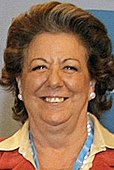|
1991 Valencia City Council election
The 1991 Valencia City Council election, also the 1991 Valencia municipal election, was held on Sunday, 26 May 1991, to elect the 4th City Council of the municipality of Valencia. All 33 seats in the City Council were up for election. The election was held simultaneously with regional elections in thirteen autonomous communities and local elections all throughout Spain. Electoral systemThe City Council of Valencia (Valencian: Ajuntament de València, Spanish: Ayuntamiento de Valencia) was the top-tier administrative and governing body of the municipality of Valencia, composed of the mayor, the government council and the elected plenary assembly.[1] Elections to the local councils in Spain were fixed for the fourth Sunday of May every four years.[2] Voting for the local assembly was on the basis of universal suffrage, which comprised all nationals over 18 years of age, registered in the municipality of Valencia and in full enjoyment of their political rights, as well as resident non-nationals whose country of origin allowed Spanish nationals to vote in their own elections by virtue of a treaty. Local councillors were elected using the D'Hondt method and a closed list proportional representation, with an electoral threshold of five percent of valid votes—which included blank ballots—being applied in each local council.[1][2] Councillors were allocated to municipal councils based on the following scale:
The mayor was indirectly elected by the plenary assembly. A legal clause required that mayoral candidates earned the vote of an absolute majority of councillors, or else the candidate of the most-voted party in the assembly was to be automatically appointed to the post. In the event of a tie, the appointee would be determined by lot.[1] The electoral law allowed for parties and federations registered in the interior ministry, coalitions and groupings of electors to present lists of candidates. Parties and federations intending to form a coalition ahead of an election were required to inform the relevant Electoral Commission within ten days of the election call, whereas groupings of electors needed to secure the signature of a determined amount of the electors registered in the municipality for which they were seeking election, disallowing electors from signing for more than one list of candidates. In the case of Valencia, as its population was between 300,001 and 1,000,000, at least 5,000 signatures were required.[2] Opinion pollsThe table below lists voting intention estimates in reverse chronological order, showing the most recent first and using the dates when the survey fieldwork was done, as opposed to the date of publication. Where the fieldwork dates are unknown, the date of publication is given instead. The highest percentage figure in each polling survey is displayed with its background shaded in the leading party's colour. If a tie ensues, this is applied to the figures with the highest percentages. The "Lead" column on the right shows the percentage-point difference between the parties with the highest percentages in a poll. When available, seat projections determined by the polling organisations are displayed below (or in place of) the percentages in a smaller font; 17 seats were required for an absolute majority in the City Council of Valencia.
Results
NotesReferences
|
||||||||||||||||||||||||||||||||||||||||||||||||||||||||||||||||||||||||||||||||||||||||||||||||||||||||||||||||||||||||||||||||||||||||||||||||||||||||||||||||||||||||||||||||||||||||||||||||||||||||||||||||||||||||||||||||||||||||||||||||||||||||||||||||||||||||||||||||||||||||||||||||||||||||||||||||||||||||||||||||||||||||||||||||||||||||||||||||||||||||||||||||||||||||||||||||||||||||||||||||||||||||||||||||||||||||||||||||||||||||||||||||||||||||||||||||||||||||||||||||||||||||||||


